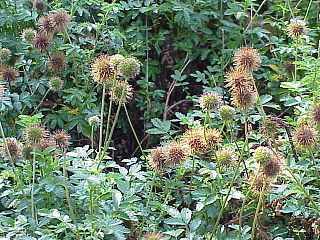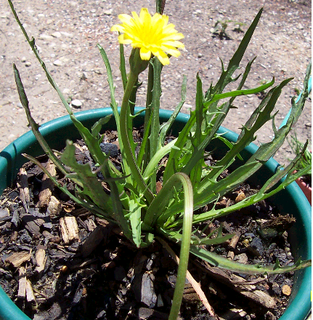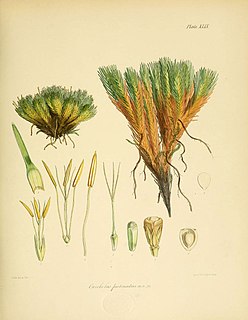
Royal Botanic Gardens, Kew, is a non-departmental public body in the United Kingdom sponsored by the Department for Environment, Food and Rural Affairs. An internationally important botanical research and education institution, it employs 1,100 staff. Its board of trustees is chaired by Dame Amelia Fawcett.

Sir Joseph Dalton Hooker was a British botanist and explorer in the 19th century. He was a founder of geographical botany and Charles Darwin's closest friend. For twenty years he served as director of the Royal Botanical Gardens, Kew, succeeding his father, William Jackson Hooker, and was awarded the highest honours of British science.

Acaena is a genus of about 60 species of mainly evergreen, creeping herbaceous perennial plants and subshrubs in the family Rosaceae, native mainly to the Southern Hemisphere, notably New Zealand, Australia and South America, but with a few species extending into the Northern Hemisphere, north to Hawaii and California.

Microseris scapigera is a yellow-flowered daisy, a perennial herb, found in New Zealand and Australia. It is the only New Zealand species of Microseris, and one of three Australian species along with Microseris lanceolata and Microseris walteri. It is classified in a group of plants, the tribe Cichorieae, that includes chicory and dandelion.

Megaherbs are a group of herbaceous perennial wildflowers growing in the New Zealand subantarctic islands. They are characterised by their great size, with huge leaves and very large and often unusually coloured flowers, which have evolved as an adaptation to the harsh weather conditions on the islands.

Eucalyptus macrocarpa, commonly known as mottlecah, is a species of mallee that is endemic to the south-west of Western Australia. It has smooth bark, usually sessile, heart-shaped adult leaves arranged in opposite pairs, large red flowers and broad conical fruit.

Nothofagus betuloides, Magellan's beech or guindo, is a tree native to southern Patagonia.
Ipomoea chrysocalyx is a vine in the family Convolvulaceae. It is endemic to Ecuador. Its natural habitat is subtropical or tropical dry forests.
Rhizanthes zippelii is a species of parasitic flowering plant without leaves, stems, roots, or photosynthetic tissue. Its flowers bud out of the roots of the Tetrastigma vine. It is found in the tropical rainforests of Java. The flowers are reddish-brown, with long hanging tips, and are from 12 to 29 cm across.

Lachnostachys is a genus of flowering plants in the mint family, Lamiaceae, first described in 1842 by William Jackson Hooker. The type species is Lachnostachys ferruginea. The genus name, Lachnostachys, comes from two Greek words/roots, lachnề ("wool") and -stachys, and thus describes the genus as having spiked woolly inflorescences.The entire genus is endemic to Western Australia

The Flora Antarctica or formally and correctly The Botany of the Antarctic Voyage of H.M. Discovery Ships Erebus and Terror in the years 1839–1843, under the Command of Captain Sir James Clark Ross, is a description of the many plants discovered on the Ross expedition, which visited islands off the coast of the Antarctic continent, with a summary of the expedition itself, written by Joseph Dalton Hooker and published in parts between 1844 and 1859 by Reeve Brothers in London. Hooker sailed on HMS Erebus as assistant surgeon.

The Ross expedition was a voyage of scientific exploration of the Antarctic in 1839 to 1843, led by James Clark Ross, with two unusually strong warships, HMS Erebus and HMS Terror. It explored what is now called the Ross Sea and discovered the Ross Ice Shelf. On the expedition, Ross discovered the Transantarctic Mountains and the volcanoes Erebus and Terror, named after his ships. The young botanist Joseph Dalton Hooker made his name on the expedition.
The Flora Novae-Zelandiae is a description of the plants discovered in New Zealand during the Ross expedition written by Joseph Dalton Hooker and published by Reeve Brothers in London between 1853 and 1855. Hooker sailed on HMS Erebus as assistant surgeon. It was the third in a series of four Floras in the Flora Antarctica, the others being the Flora of Lord Auckland and Campbell's Islands (1843–45), the Flora of Fuegia, the Falkland Islands, etc (1845–47), and the Flora Tasmaniae (1853–59). They were "splendidly" illustrated by Walter Hood Fitch.
The Flora Tasmaniae is a description of the plants discovered in Tasmania during the Ross expedition written by Joseph Dalton Hooker and published by Reeve Brothers in London between 1855 and 1860. Hooker sailed on HMS Erebus as assistant surgeon. Written in two volumes, it was the last in a series of four Floras in the Flora Antarctica, the others being the Flora of Lord Auckland and Campbell's Islands (1843–45), the Flora of Fuegia, the Falkland Islands, etc (1845-47), and the Flora Novae-Zelandiae (1851–53). They were "splendidly" illustrated by Walter Hood Fitch.

The Flora of Lord Auckland and Campbell's Islands is a description of the plants discovered in those islands during the Ross expedition written by Joseph Dalton Hooker and published by Reeve Brothers in London between 1843 and 1845. Hooker sailed on HMS Erebus as assistant surgeon. It was the first in a series of four Floras in the Flora Antarctica, the others being the Flora of Fuegia, the Falklands, Kerguellen's land, etc (1845–1847), the Flora Novae-Zelandiae (1851–53), and the Flora Tasmaniae (1853–59). They were "splendidly" illustrated by Walter Hood Fitch.

Tupeia is a monotypic genus of semi-parasitic shrubs (mistletoes) which occurs in both the North and South Islands of New Zealand. There is only one species in the genus: Tupeia antarctica. There are no synonyms.

Acaena microphylla, the bidibid or piripiri, and outside New Zealand, New Zealand-bur, is a small herbaceous, prostrate perennial flowering plant in the rose family Rosaceae, native to both the North and South Islands of New Zealand. There are two varieties:

Anisotome antipoda is a species of flowering plant in the family Apiaceae, which is endemic to the Auckland, Campbell and Antipodes Islands.

Acaena lucida is a small plant in the Rosaceae family, which is native to southern Chile, southern Argentina and the Falkland Islands.

Oreobolus pectinatus is a species of flowering plant in the sedge family that is native to the subantarctic islands, and to the North and South Islands of New Zealand. The specific epithet derives from the Latin, pectin/pectinis,, and refers to the leaves.














